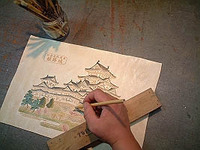

Total:131items
- Pottery & Porcelain (18)
- Lacquerware (4)
- Glasswork (2)
- Wood & Bamboo Work (19)
- Leather Work (1)
- Papermaking (13)
- Textile (20)
- Dyeing products (5)
- Masonry (1)
- Metal Work (11)
- Stationery (4)
- Livingware (3)
- Accessory (4)
- Toys & Entertainment (14)
- Interior (2)
- Other crafts (10)

 |
Main Production Site:Hyogo |
 《Characteristics》
《Characteristics》Himeji (Hyogo pref in western Japan) have been flourished as a castletown around ever beautiful Himeji Castle (a Japanese National Treasure, also known as Shirasagi-jo; Egret Castle), as well as a Himekawa, Himeji White Tanned Leather production area in the region of Harima(old name of southwest Hyogo).
The Himeji-specialty Himekawa has such wonderful characteristics that it is shiny white without bleaching or dyeing, and it becomes even whiter by the exposure to the sunlight. Gorgeous patterns are embossed and hand-painted on this leather to produce small goods such as wallets and bags, so-called Himekawa Crafts.
The supple, light yet durable Himekawa crafts will be your long-term favorite.
[A Designated Traditional Craft by the prefecture of Hyogo]
Contents provided: Castle Leather Co.
Translation: Yoko Hokari, reviewed by Yuka Toguchi
Check It Out!
Himekawa products are available at online shop WA-YOU-EN.

| Materials | Cow Leather |
|---|---|
| Crafting Processes | The manufacturing of Himekawa work includes five steps of leather production processes, the key part of this traditional craftsmanship, and one step of sewing.
[1] Rough Cutting The leather production processes starts with tracing outlines of patterns onto leathers with pencil with caring about these characteristics. Then, the leathers are cut out roughly. The outlines are larger than the actual size because leathers shrink in later processes. [2] Graining Next, grains called Shibo are made on the leathers by kneading. Kneading is the way to bring out natural grains on leathers. [3]Embossing Thirdly, various patterns are stamped onto the leathers. Stamping gives the patterns three dimensional appearances and makes the leathers fit comfortably in our hands. Craftspeople choose patterns which fit to the size and shape of finished products. The stamps used to be wooden but now they are made of metal. [4]Painting Then, the leathers are painted with brushes, by using distinctive painting techniques, such as gradation, double coat, and single coat. Craftspeople can paint only limited portion in a day and the workload is determined by the size and design of the leathers they work. It takes about between 12 and 20 hours to get dry, depending on the weather. [5]Staining Lastly, the leathers are stained by other coating materials called Sabi (lacquers and pigments) and varnished as the finishing. Staining Sabi makes patterns and graining on the leathers appear and Varnishing protects surfaces of the leathers against scratches, water, and dirt. After staining Sabi, the leathers need to be dried naturally. So craftspeople pay close attention to the drying condition especially the humidity and temperature. [6]Sewing The Leather production processes take four days or longer, depending on the weather. Once the leather production processes are done, they are cut out at actual size and sewed. To utilize beautiful patterns, craftspeople provide thoughtful needlework in consideration of characteristics of leathers. Himekawa is very light, so recently it is used to make bags and pouches. |
| History | The techniques for making white tanned leather have long history; they were established around the 4th or 5th century. Then, the craftsmanship became popular from the Sengoku period (the 15th century) through Azuchi-Momoyama period (the early 17th century). During the periods, attention-getting pattern was a trend among rulers including Hideyoshi Toyotomi, a legendary feudal warlord who became the chief adviser to the Emperor in the late 16th century. Due to their demands, the light, strong, and pliant leather was used to make their armors and harness.
The techniques which provided brilliant, decorative armors and harness have handed down and have been highly valued. During the peaceable Edo period (from the beginning of 17th century to the late 19th century), craftspeople started making small products, such as cigarette boxes or letter boxes, with the special leather. Now, they make more fashion or interior goods such as bags, wallets, stationary boxes, or centerpieces on the table with the techniques. |
◆Exhibition / Showcase
*Himekawa products are available at online shop WA-YOU-EN.



